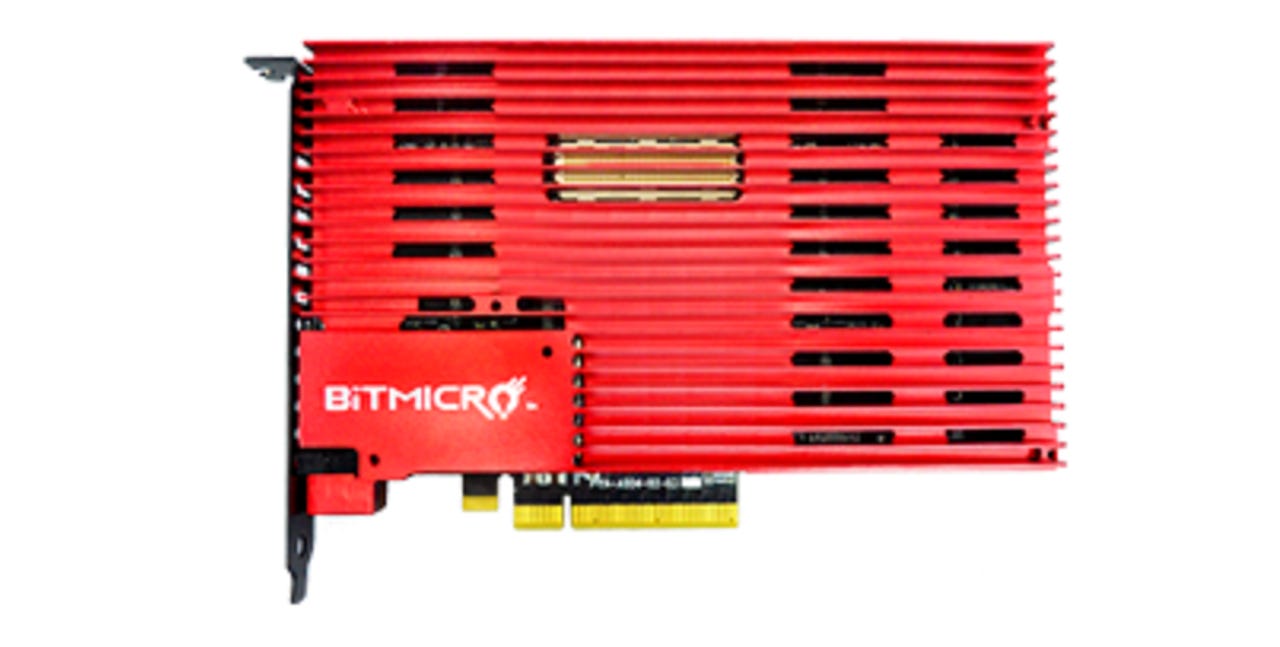BiTMICRO targets content delivery and big data


Zophar Sante, VP of Worldwide Marketing and Sales of BiTMICRO and COO of BiTMICRO Networks International, Inc., introduced me to his company, what it's trying to accomplish and his company's newest product, BiTMICRO MAXio E-Series PCIe solid state storage device (SSD). The company has focused itself on changing how storage is used and has been offering innovative storage products for military and industrial applications since the late 1990s.
Where BiTMICRO has been
BiTMICRO's products made it possible for intelligent devices to be used in aircraft, in industrial processes and even in sensors that are lowered into wells. Rotating media wouldn't work well in these types of environments due to the heat, vibration, particulate matter in the air and for a number of other reasons, so the company designed its own solid state storage devices and controllers that would.
What the company doing now
BiTMICRO has decided to take its industrial strength storage technology and apply it to commercial and enterprise level applications. Their goal is to offer SSD storage with very large capacity, high performance and long life, which make it a good choice to be the only storage deployed in these applications. Due to the high levels of throughput these devices offer, the company believes that their devices are a perfect match for applications requiring a large amount of storage capacity and able to support a huge amount of data throughput. Sante mentioned that BiTMICRO is targeting content delivery and big data analytics out of the gate.
MAXio E-Series PCIe SSD
Here's how the company describes its new product:
BiTMICRO® Networks, Inc.'s MAXioTM E-Series PCIe solid state drives (SSDs) is powered by BiTMICRO’s patented Talino™ ASIC Architecture. The new MAXio E-Series SSD delivers superior capacity, performance and reliability for companies that need to support high volume application workloads.
Key features of BiTMICRO MAXio E-Series PCIe SSDs include:
- High Capacity: MAXio E-Series SSDs incorporate a Split-ASIC architecture utilizing BiTMICRO designed Talino ASIC and BiTMICRO FBX flash expansion ASIC. MAXio E-Series SSD capacities are from 1.5TB to 6TB.
- MAXio E-Series SSD Capacity and Performance balance: The MAXio E-Series PCIe SSD is designed for ideal performance in read-intensive applications. MAXio SSD’s flash controller optimizes flash, performance and scalability.
- Dynamic Wear Leveling: The usable life of MAXio SSDs, with dynamic wear leveling managing the usability of the drive’s flash chips is up to five years.
- Easy-to-use SSD Management Tool: DriveLight™ Management Software allows users to easily change drive settings for optimal use.
Analysis
Tech Pro Research
BiTMICRO has been around for quite some time and yet I hadn't heard of them. That's because the company chose a narrow market segment — military and industrial processing — rather than address the needs of the market as a whole. By trying to move into the larger market, the company is leaping into a very busy, very dynamic market that has quite a number of suppliers of SSD-based caches, storage devices and even complete storage systems. It faces competition from companies such as EMC, HDS, HP, IBM, NetApp and quite a few smaller suppliers.
Most of the competitors are marketing their products by pointing out the high number of I/O operations per second (IOPs) their products will support. They claim their products are a great addition to environments supporting transactional or database processing. SSDs offer other interesting storage attributes, such as low latency and high levels of read activity too.
BiTMICRO intends to focus on supporting very large amounts of storage and applications needing very high levels of read throughput, such as content delivery and big data analytics, rather than starting out with a focus on transactional systems. That, Sante pointed out, will come later.
The company has an interesting story and a colorful history. I'll be watching them and suggest you do too.